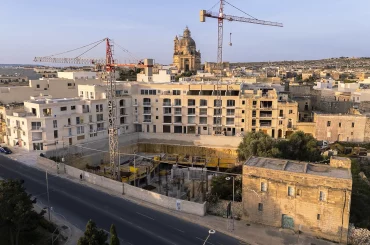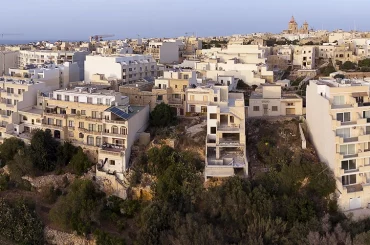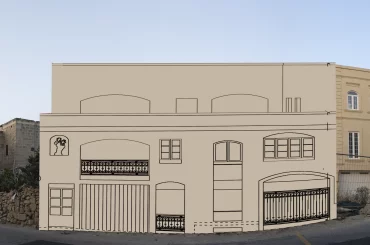Update 14 June
The Planning Authority has granted permit to this pool: a new investigative report is being prepared.
In its third meeting on a contentious case, the Planning Commission may grant permit to a swimming pool on the side of a valley – and at the bottom of a ridge – that would signify a departure from policy on swimming pools probably further than anything seen before.
Twice has the Planning Directorate – the technical team of the Planning Authority – reiterated that a pool at the bottom of the ridge is in breach of policy. And twice has the Planning Commission, which decides on applications, engaged with the architect and requested a smaller pools and other tweaks. The third hearing is now scheduled for Tuesday.
The swimming pool is proposed as an extension at the back of an 8-level block of flats belonging to Excel Investments Limited, which is owned by Joseph Portelli (majority shareholder), the Agius brothers (Ta Dirjanu) and Daniel Refalo. The building itself, called The Valley, was granted permit in 2019 despite ridge-edge policies that were (are) supposed to preclude such developments.

In planning policies, ridges in Gozo are "sensitive" and subject to specific policies. The latest policy to do so was published in November of 2015, called DC15, and research by this website suggests that The Valley is the most blatant departure from ridge-edge policies at least since then, if not since publication of Local Plan in 2006.
Policy P3 of DC15 sets various parameters that "must be respected" when it comes to ridge-edge developments, including this: "A distance must be kept from the ridge edge so as not to impinge on the sensitivity of the area and to allow for adequate excavation to occur if physically possible."

The Local Plan’s policies make similar points.

Observance of Local Plan ridge-edge specifications slackened over the years, with ridge-edge buildings of three or four storeys being approved. But The Valley went further: an 8-level block that necessitated gouging the cliff itself. It is visible from miles around as the most imposing building on the entire ridge.

Swimming pools that fall beyond the development lines are allowed within certain parameters, and such policy then specifically tightens the parameters when it comes to ridge edges. It says: “The policy on Swimming Pools ODZ (Feb 2000) shall not be applicable to ODZ areas adjacent to ridge edges unless it can be proven that these interventions are occurring on existing (permitted) established gardens, and the intervention complements the sensitive characteristics of the ridge edge.”
Although Swimming Pools ODZ (Feb 2000) was superseded by Policy 6.4 of the Rural Policy and Design Guidance, the provisions on pools on ridges in Gozo remains unchanged.
Yet the Planning Commission engaged with the architect during the first meeting on swimming pool proposed for The Valley, asking for tweaks and “to indicate any similar legal commitments in the area on a block of appropriate scale.”
The architect made reference to a building 200 metres up the road. Yet that building is half the width of The Valley and it’s more integrated among other buildings. The contour is also different – the slope is steeper, and rockier cliff-like, at The Valley site – and the long-distance view (hence visual impact) is incomparable.

Yet in the second meeting, even though the Planning Directorate reiterated that the proposed pool is in breach of policy, the Planning Commission asked the architect to reduce the size of the pool even further, in effect making it the same size as the pool of that other building, as well as introduce terracing, with a view to eventually granting a permit.
This means the Planning Commission may end up using a superficially-comparable precedent to permit a pool more clearly at odds with policies, and in the process create a further precedent yet – and further departure from the policies on pools on ridges.
This issue of precedent was raised by some of the dozens of objectors, including the Xaghra Local Council, who wrote to the Planning Authority on this case.
If that precedent had to become a trend – and this is how the Planning Authority tends to operate – pools may proliferate at the foot of the cliff, and other buildings similarly spill down the cliff-face.
This would signify further encroachment into Outside Development Zone, mar further the view of the quintessential ridge, and destroy trees in the lush maquis habitat below this ridge.
The video published above – as the featured image of this article – shows how other swimming pools could potentially propagate over the maquis. (Note: the actual pools digitally rendered in the video are larger than they would truly be on site – the digitally rendered proposed pool behind The Valley is also larger. The size of pools shown in the video show the potential size of site commitments, or the larger footprint, and that would include pool, decking, structures, lawn and perimeter: the footprint in this sense shows the extent of maquis that would be destroyed. The proposed pool behind The Valley is accurately rendered in the picture below.)

Court renounces precedent
Various court judgements have emphasized that precedent or other similar developments offer no justification in instances where polices are clear.
In one of those judgements – Noel Emanuel sive Noel Ciantar vs L-Awtorita tal-Ippjanar – the Court of Appeal said: “With reference to the submission of the Planning Authority that similar permits were approved, this court has on various occasions considered that in cases where the law is clear no permit that in the opinion of the Court goes against what is specified in law can constitute some form of derogation from law and the applicable principles.”
By law and principles, the Court of Appeal was referring to clear policies in the Local Plan, which takes precedence over any other “supplementary guidance” policies such as swimming pools in ODZ policies.
In yet another judgement, the Court of Appeal held that “the court was clear that no consideration can ever overcome the fact that a permit cannot be issued if the application is against law, plan, or policy. The Court reiterates in this appeal that when the legislator is clear and leaves no room for discretion in interpretation or diverse treatment, the Authority, Tribunal and Court are constrained by what was intended by the legislator.”
The judgement then added that the Planning Authority has to “ensure that these principles are observed.”
Donate to Planning Emergency
The planning-related investigative articles published on this website take time, resources, and effort to put together. The robustness of the research and professionalism of the delivery makes an impact. Your support is needed to sustain this kind of impactful reportage. This website's donation setup is uniquely transparent, with target amounts – you donate to what you choose to donate and see the targeted amount grow. Click on button below to learn more, and consider donating as little as €5.




